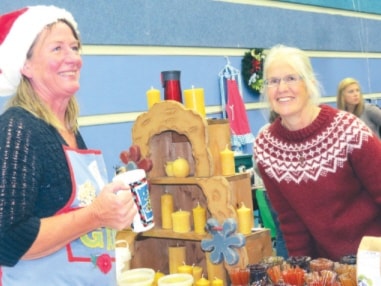It’s delicious. It’s sweet. It’s healthy and free of additives.
It’s honey!
Emery’s Honey House northwest of Bluffton has been in operation for more than 30 years. Even though owners Chester and Bonnie Emery have faced many unforeseen challenges they have kept on, keeping on.
“We enjoy it though sometimes you do think about a different career like nursing or something, but we’ve decided to stick it out and we’ve done okay,” said Bonnie Emery.
The Emerys’ interest in beekeeping began several years ago when they lived in British Columbia.
“It was something that suited both of us,” said Emery. “We wanted to farm and live in the country.”
The couple purchased a beekeeping operation from a Bluffton man who had his honey house set up in the old creamery in town. The creamery was destroyed by fire.
“It was a big loss, his whole crop burned and he put his operation up for sale,” Emery recalled. “The bees were out in separate bee yards and they were safe.”
She and her husband purchased the bees, bought a quarter section and built their own honey house.
Over the years they have enjoyed a successful beekeeping business, but Emery said new challenges continue to present themselves such as dealing with new farming methods that involve using more chemicals and fewer plant species (mono culture farming). The blood sucking varoa mite, which weakens the bees’ immune system, has also been prevalent the last few years, she said.
“It’s hard on the bees. It needs to be controlled. If you don’t stay on top of it, you could lose a large percentage of your hives in one year.”
Honey is extracted from the hives in the honey house and packaged for sale. Some honey is poured into 45-gallon drums and shipped to Sioux City, Iowa.
“The demand for honey goes up and down. It’s decent right now,” said Emery.
Operating a beekeeping operation is physically demanding and the Emerys continue to do most of their work manually, hiring local youths to help out during the busy summer months.
“There are lots of great kids out there. We have always enjoyed hiring local kids to work with us,” she said.
Although all workers dress in protective clothing, bee stings can happen, especially when the honey is being harvested.
“The kids rarely get stung, but it can happen especially when they are harvesting the honey. The bees are not very aggressive, but they do have a venom.”
Emery also makes beeswax candles that she sells at farmers’ markets.
“I consider it a little cottage industry,” she said.
The bee farm requires work year round with the busiest time being from April to October.
“We prepare the bees for the flowers. As well as a sweetener, honey can be used as an antiseptic for burns or other minor skin injuries. It is also popular for cosmetic use.
But the primary use for honey is to taste, savor and enjoy.
And the best part is “it’s considered good for you,” said Emery.
